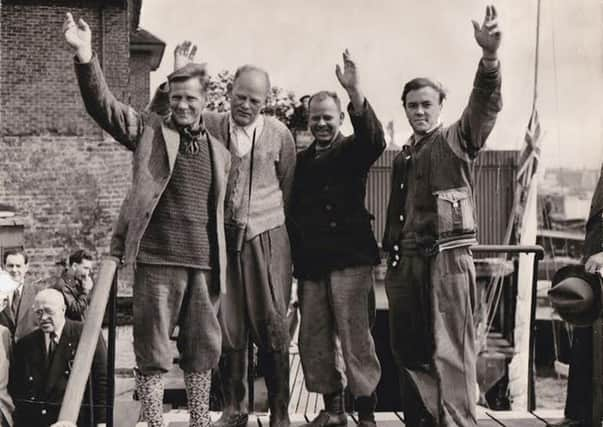Life after the war of WWII hero revealed


But the amazing bravery of Leif Larsen - and his many fearless comrades - has overshadowed a later achievement made by the Norwegian seaman, who was decorated by both the UK and Norwegian governments for his WWII exploits.
After the war, Larsen went on to test a prototype aluminium-built lifeboat which was to become the first foreign-made craft to be approved by the Department of Transport for use in British vessels.
Advertisement
Hide AdAdvertisement
Hide AdTo prove its capabilities, he and three others undertook a 800-mile crossing over the North Sea from Norway.
Prior to that, Larsen had amassed an astonishing number of missions which earned him hero status in both Shetland and Norway.
He assisted in the Shetland Bus operation which saw fishermen and locals help save refugees from Nazi-occupied Norway and provide much needed resources to an underground movement.
His life after the war is little mentioned, but Shetland Bus historian Mark Burgess described Larsen’s work as revolutionary.
He explained: “In the insular world of 1950s Britain, the approval of a foreign supplier of lifeboats was a momentous event.
“The creation of an aluminium lifeboat was also ground-breaking, being lightweight, buoyant and sturdy.”
It was in August 1953 that four highly-skilled seamen, captained by Larsen, set sail across the North sea, bound for London from Oslo.
It became an epic 800-mile journey, but proved so successful it made way for a new type of vessel - and pave the way for another future lifesaver akin to those of the past efforts of the Shetland Bus days.
Advertisement
Hide AdAdvertisement
Hide AdThe open boat, called the Norfly, was heavily ballasted to simulate her intended use when filled to capacity - meaning carrying up to 46 seamen who may need to be rescued from the water.
Mr Burgess said: “The sea crossing itself was remarkable, made using a combination of sail and the 10horsepower engine.
“The estimated time for the crossing was around 12 days, but the crew made it in only five or six days.
“Although the weather was far from ideal, the sailing went well until the later stages. Already pushing into a headwind, the lifeboat paused for some time near Lowestoft to allow photographs to be taken by an aeroplane and the weather worsened further by the time they were once again under way for London.
“The vessel was hammered, shaking as she pitched in heavy seas, plunging her stem deep into oncoming swells that overran her gunwales, but not a rivet sprung in her aluminium-plated, heavily laden hull and inspection proved the worth of her construction when she was lifted out at her destination.”
The journey made international news - for a day - but was then widely forgotten outside the maritime world.
One of the crew was quoted as saying they were “hanging on for dear life”.
However, Mr Burgess said: “Larsen wryly described the journey as a ‘cakewalk’ and a ‘nice little holiday’.”
Advertisement
Hide AdAdvertisement
Hide AdThe Norfly became the first foreign-made craft to ever be approved by the Transport Ministry for use in British vessles.
She went on display at the Engineering, Marine and Welding exhibition at Olympian and, along with three identical lifeboats, were purchased for supply to the British Tanker Co.
The Norfly was built by Norsk Flyindustri A/S of Norway.
Beside Larsen at the helm was an English engineer Fred Philpott, an expert with the Petters engine that drove the craft and a former wartime submariner.
A Norwegian marine journalist called Harald Nicolasien was the third crewmember. He was a friend of LArsen and former Merchant Navy man and had the role of navigator and radio operator.
The fourth was a Canadian, John Helston, who was a trainee publicist for the holding company that owned Petter Limited at that time. His role was to document and film the journey and provide general assistance.
It is through the family of Philpott that the history of this unique sea crossing has been collated and passed to the Scalloway Museum in Shetland, which holds a massive archive on the operations of the Shetland Bus and Larsen as it was a base during the WWII exploits between Norway and its neighbours.
Mr Burgess said: “It will become part of the museum’s archive and add further depth of knowledge to the heroic life of the man known as Shetland’s Larsen - and adds to it an English engineer named Philpott who modestly became part of post-war maritime history.”
The Shetland Bus operation began after the occupation of Norway by German forces in April 1940, resulting in the country surrendering in June that year.
Advertisement
Hide AdAdvertisement
Hide AdRefugees fearing for their lives fled, the majority of which landed over the North Sea in Shetland.
Also, almost simultaneously, Norwegians began training with the British Armed Forces while there were also thousands of Norwegian servicemen hiding in their country needing only weapons and communications to become an effective underground movement.
Secret bases were set up in Shetland where hundreds of missions were carried out, using fishing boats which had carried refugees to the islands.
These landed agents, radio sets, weapons and ammunition, and returned with further refugees.
This vital sea link became to be known as The Shetland Bus and, despite massive success, there will inevitably many fatalities with boats being sunk by the Germans, while others were lost in bad weather – resulting in around 30 deaths.
In 1943 the fishing boats were replaced by three fast and well-armed sub-chasers provided by the US Navy and these continued operation virtually unscathed.